Bannerman's Island Arsenal
POLLEPEL ISLAND, FISHKILL, NEW YORK
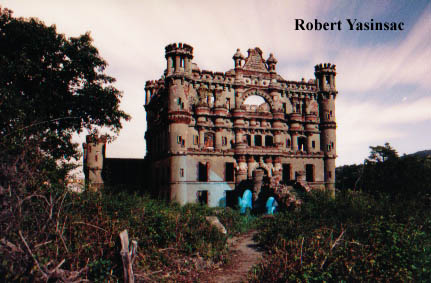
Bannerman's Island Arsenal
POLLEPEL ISLAND, FISHKILL, NEW YORK

UPDATE JANUARY 26, 2010: UPDATE DECEMBER 28, 2009: Day-trippers
on the Hudson, be it by boat or by train, or across one of the many bridges,
can marvel the majestic natural landscape of the Valley, all the way from
the Palisades near New York City, up to the Hudson Highlands past West
Point, and beyond. Further up the river, at Garrison,
Castle Rock, looking like it was transported from the middle of Germany,
looms over Route 9 and looks across to West Point. Still in Garrison, Dick’s
Castle rises up from the hills, renovated and sparkling white, white as
the proverbial white elephant it is.
Just north of Cold Spring,
the traveler passes Storm King on the west and Breakneck on the east. Ahead
is Pollepel Island. The many prominent buildings I have mentioned were
all built as residences. What sets "Bannerman's Castle" apart is that it was
built as a warehouse. Only more glorified than a modern warehouse.
Bannerman's Island Arsenal was constructed
in stages between the years 1901-1918 by Francis Bannerman VI. Bannerman
started a business after the Civil War, purchasing military equipment surplus
from the U.S. Government at scrap prices, through sealed bids. The business
eventually outgrew the Bannerman warehouses in Brooklyn, where large stores
of black powder may also have unnerved local residents. The Castle was
never a museum, despite the interesting relics that could be found there.
Nor was it a store; sales went through the New York store, or shipped
direct from the island. So if this place was just a warehouse, then why
the conspicuous construction? Certainly none of today’s major e-commerce
retailers would waste so much effort and cost on fanciful building meant
to temporarily store “stuff.” Proud of his heritage, and
with a strong interest in the antiquities, Francis Bannerman VI studied
castles all over Europe, especially his native Scotland. Piecing together
the many designs, some sketched on hotel stationery, the buildings were
designed by Bannerman himself. You won’t find Bannerman's
Island Arsenal in the architectural
journals of the day because professional architects were not consulted
in the design of the structure. There was a residence on the island, and
several other buildings were constructed. Ever the astute businessman,
Bannerman made his warehouse a giant billboard. Traveling along the river
has always been popular; those going by boat or train cannot miss Bannerman's
Island Arsenal . So Bannerman plastered his name all over the
warehouse. Although the
island is officially named Pollepel,
Bannerman placed the legend “Bannerman's Island Arsenal’
on the north and east sides of the Number Three Warehouse. Privately, he
referred to the island as Crag Inch, Scottish for "rocky island." -With information from The Story of Bannerman Island
,
Charles S. Bannerman, 1962 Information about
purchasing Bannerman's Castle images
by Rob Yasinsac can be found at this link.
The Bannerman Castle Trust
Other Contacts:
Bannerman Castle Links :
More of Bannerman's Castle collapsed in yesterday's storm, including all of the
north wall of the tower, which had not yet collapsed to any degree. Only the
west wall and part of the south wall of the Tower remain. The lodges, the Number
Two Arsenal and the Number Three Arsenal still stand. The Mid-Hudson News has an
article in today's online edition regarding the latest collapse. Click
here to see a photograph of the castle ruins taken this afternoon.
A significant portion of the tower at Bannerman's castle collapsed the weekend
of December 26-27. 2009. Please click
here for more information.
NOTE:
The Official website of the Bannerman Castle Trust, Inc., can be found at
www.bannermancastle.org.
Bannerman Castle and Pollepel Island are closed to the public and accessible
only through tours arranged by the
Bannerman
Castle Trust. Do not
attempt to land on the island or enter the harbor surrounding the Island. If
you appreciate the existence of a place like Bannerman Castle, please support
the work of the volunteers who have helped make such a place accessible to the
general public. By visiting the right way, not only do you learn about the site
from trained tour guides, but you also help ensure the continued existence and
preservation of the site. Preservation is not possible without support from
people who want to see these places survive. My images were obtained as a result of
volunteering my time and services
for the Bannerman Castle Trust.
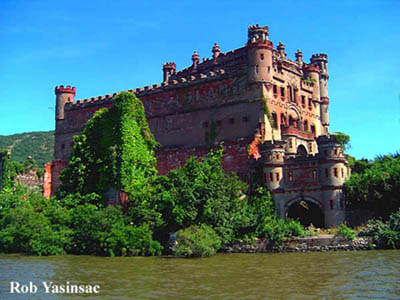
Along the way, man made elements
of the scenery will distract your eye from the river and the hills. The
railroad takes you within a few feet of Washington Irving’s Sunnyside.
Jay Gould’s Lyndhurst is visible from the river. And if you are driving
east on the Tappan Zee Bridge, look to the top of the hill in the distance
in front of you, and you can see Carrollcliffe, a castle that was built
approximately the same time as Bannerman Castle.

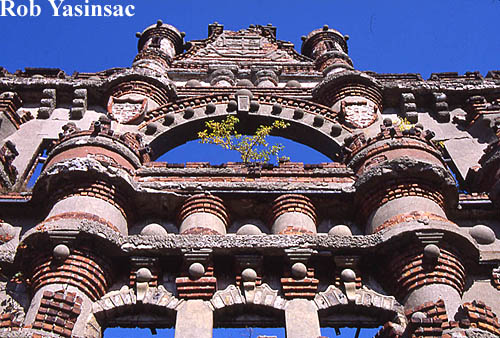
South facade, Crag Inch Tower.
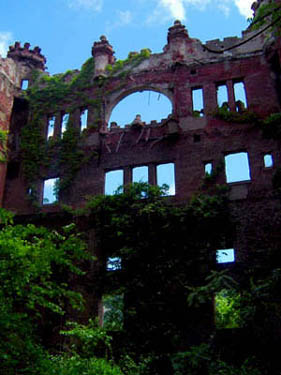
The Bannerman
business used the island until the late 1950s, when the Castle was cleared of military
surplus and live munitions were deactivated. Although a mishap or
two occurred during the years of active operation, including the powder house explosion
of 1920, it was not until after
the State of New York purchased the Island in 1967 and a fire of undetermined origin
in 1969 that the buildings fell
into their present state of ruin. Now, a Friends organization known as the Bannerman
Castle Trust is working with the State of New York towards the goal of
stabilizing the Castle
and possibly restoring the residence. With featured articles in the New York Times,
among other newspapers, and successful ventures that brought artists, students
and the public to the Island since the late 1990s, Bannerman’s Castle is getting
much deserved attention. Thanks to the efforts of the Trust, the trails
have been cleared, and the buildings are now more visible from the river
and the railroad. Continued efforts of the Trust have made it possible that New
York State has allowed the island to be opened for tours arranged by the
Trust on a more regular basis
during summer weekends.
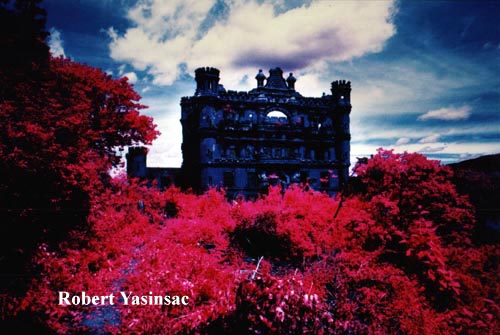
Crag
Inch Tower, color infrared film.
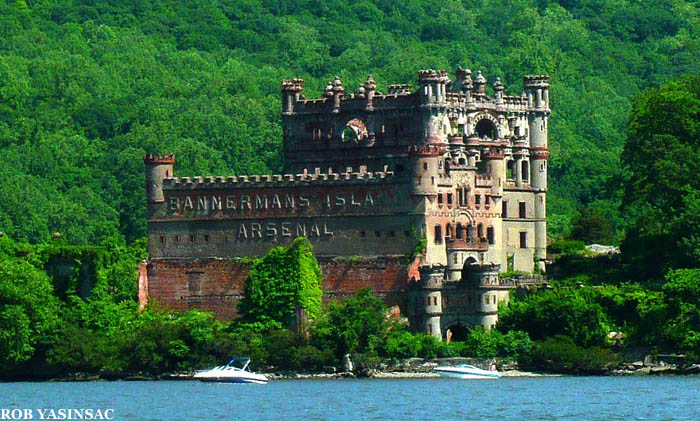
View from the north.
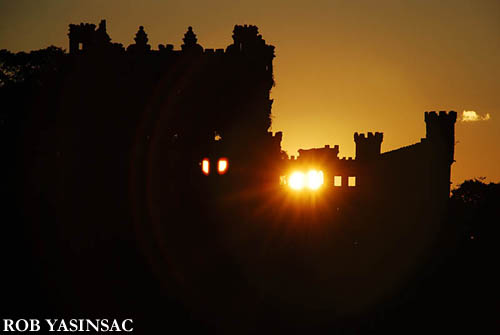
Sunset
through the windows.
To volunteer, become
a Friend of the Trust, or make a donation, write:
PO BOX 843
Glenham, NY 12527
phone:(845)-831-6346
www.bannermancastle.org
- The official page of the BCT.
The Bannerman Castle Trust Inc, seeks to raise money to preserve Bannerman
Castle on Pollepel Island as an historical, educational and cultural site.
Paths on the Pollepel Island have been cleared and views of the buildings
have been restored, in hopes of allowing general public access in the near future.
Access to the island is prohibited and New
York State Parks police routinely patrol the Island for trespassers.
New York State, Office of Parks, Recreation and Historic
Preservation.
Empire State Plaza, Agency Building 1, Albany, New York,
12238
HudsonValleyRuins.org - Tom Rinaldi's Bannerman Castle page.
HudsonRiver.com
- An overview of the Island's history, illustrated by three Thom Johnson photographs.
BannermanIsland.com - A Tribute to
an Island.
O'Boyle Photo
- Shaun O'Boyle's photos.
Exploring and
Modern Ruins - Xydexx's photos.
Yaz’ Hudson
Valley Ruins and Abandoned Buildings, etc.
This page copyright © 2010 by Robert J. Yasinsac.
All rights reserved. 
Reproducing or copying these photographs
without the permission of Robert Yasinsac is prohibited.